流过圆柱的闭环旋转控制:实验研究
IF 3.3
2区 工程技术
Q2 ENGINEERING, MECHANICAL
Experimental Thermal and Fluid Science
Pub Date : 2025-07-05
DOI:10.1016/j.expthermflusci.2025.111557
引用次数: 0
摘要
在雷诺数Re=100条件下,对圆筒形流体的闭环旋转控制进行了实验研究。为了支持本研究,开发了一个集成图像对采集、实时粒子图像测速(PIV)处理和驱动器驱动的实验平台,采用多线程技术提高性能。当汽缸在水箱中以恒定速度拖曳时,记录下游尾迹,通过实时PIV处理确定反馈速度信号。随后,气缸由电机驱动旋转,转速由比例控制得到。不同比例系数kP的实验结果表明,闭环控制对流场有显著影响。当kP>;0时,传感器位置的下游速度波动减小。实施kP=1.0的最优控制后,横向速度波动幅度大幅减小,降至52%。此外,这种控制策略导致了再循环区域和涡形成区域的延伸。速度波动的减小,如法向雷诺应力所示,表明涡脱落得到了有效的控制。而在kP<;0的情况下,下游尾迹型转变为“C(2S)”型,导致横向速度波动显著增加。局部线性稳定性分析表明,控制机构可以有效地影响尾迹稳定性,在最有效的控制参数下,将绝对不稳定区域拉长38.6%,同时降低了敏感扰动频率。除了提供闭环旋转控制的实验证据外,本研究还介绍了一种利用实时PIV生成速度场的方法,以调节钝体周围的流动。本文章由计算机程序翻译,如有差异,请以英文原文为准。
Closed-loop rotary control of flow past a circular cylinder: An experimental study
An experimental investigation of closed-loop rotary control for flow past a circular cylinder has been conducted at a Reynolds number of . To support this study, an experimental platform is developed that integrates image pair acquisition, real-time particle image velocimetry (PIV) processing, and actuator driving, employing multithreading technology for enhanced performance. When the cylinder is towed in the water tank at a constant velocity, the downstream wake pattern is recorded to determine the feedback velocity signal via real-time PIV processing. Subsequently, the cylinder is driven to rotate by a motor, with the rotational velocity derived from proportional control. Experimental results for various proportional coefficients indicate that the closed-loop control significantly influences the flow field. When , the downstream velocity fluctuations at the sensor location exhibit a reduction. The implementation of optimal control with leads to a substantial decrease in the amplitude of transverse velocity fluctuations, reducing it to 52%. Additionally, this control strategy results in an elongation of both the recirculation region and the vortex formation region. The reduction in velocity fluctuations, as indicated by the normal Reynolds stress, suggests effective control of vortex shedding. However, in scenarios where , the downstream wake pattern transitions to the “C(2S)” mode, resulting in a significant increase in transverse velocity fluctuations. Local linear stability analysis demonstrates that control mechanisms can effectively affect the wake stability, elongating the absolutely unstable region by 38.6% for the most effective control parameter while reducing the sensitive disturbance frequency. In addition to presenting experimental evidence for closed-loop rotary control, the current study introduces a methodology for employing real-time PIV to generate velocity fields for the purpose of regulating flow around a bluff body.
求助全文
通过发布文献求助,成功后即可免费获取论文全文。
去求助
来源期刊

Experimental Thermal and Fluid Science
工程技术-工程:机械
CiteScore
6.70
自引率
3.10%
发文量
159
审稿时长
34 days
期刊介绍:
Experimental Thermal and Fluid Science provides a forum for research emphasizing experimental work that enhances fundamental understanding of heat transfer, thermodynamics, and fluid mechanics. In addition to the principal areas of research, the journal covers research results in related fields, including combined heat and mass transfer, flows with phase transition, micro- and nano-scale systems, multiphase flow, combustion, radiative transfer, porous media, cryogenics, turbulence, and novel experimental techniques.
 求助内容:
求助内容: 应助结果提醒方式:
应助结果提醒方式:


